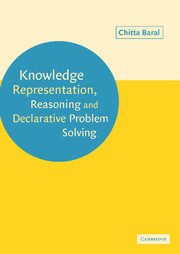Book contents
- Frontmatter
- Contents
- Preface
- 1 Declarative programming in AnsProlog*: introduction and preliminaries
- 2 Simple modules for declarative programming with answer sets
- 3 Principles and properties of declarative programming with answer sets
- 4 Declarative problem solving and reasoning in AnsProlog*
- 5 Reasoning about actions and planning in AnsProlog*
- 6 Complexity, expressiveness, and other properties of AnsProlog* programs
- 7 Answer set computing algorithms
- 8 Query answering and answer set computing systems
- 9 Further extensions of and alternatives to AnsProlog*
- Appendix A Ordinals, lattices, and fixpoint theory
- Appendix B Turing machines
- Bibliography
- Index of notation
- Index of terms
1 - Declarative programming in AnsProlog*: introduction and preliminaries
Published online by Cambridge University Press: 13 August 2009
- Frontmatter
- Contents
- Preface
- 1 Declarative programming in AnsProlog*: introduction and preliminaries
- 2 Simple modules for declarative programming with answer sets
- 3 Principles and properties of declarative programming with answer sets
- 4 Declarative problem solving and reasoning in AnsProlog*
- 5 Reasoning about actions and planning in AnsProlog*
- 6 Complexity, expressiveness, and other properties of AnsProlog* programs
- 7 Answer set computing algorithms
- 8 Query answering and answer set computing systems
- 9 Further extensions of and alternatives to AnsProlog*
- Appendix A Ordinals, lattices, and fixpoint theory
- Appendix B Turing machines
- Bibliography
- Index of notation
- Index of terms
Summary
Among other characteristics, an intelligent entity – whether an intelligent autonomous agent, or an intelligent assistant – must have the ability to go beyond just following direct instructions while in pursuit of a goal. This is necessary to be able to behave intelligently when the assumptions surrounding the direct instructions are not valid, or there are no direct instructions at all. For example even a seemingly direct instruction of ‘bring me coffee’ to an assistant requires the assistant to figure out what to do if the coffee pot is out of water, or if the coffee machine is broken. The assistant will definitely be referred to as lacking intelligence if he or she were to report to the boss that there is no water in the coffee pot and ask the boss what to do next. On the other hand, an assistant will be considered intelligent if he or she can take a high level request of ‘make travel arrangements for my trip to International AI conference 20XX’ and figure out the lecture times of the boss; take into account airline, hotel and car rental preferences; take into account the budget limitations, etc.; overcome hurdles such as the preferred flight being sold out; and make satisfactory arrangements. This example illustrates one benchmark of intelligence – the level of request an entity can handle.
- Type
- Chapter
- Information
- Publisher: Cambridge University PressPrint publication year: 2003
- 1
- Cited by



